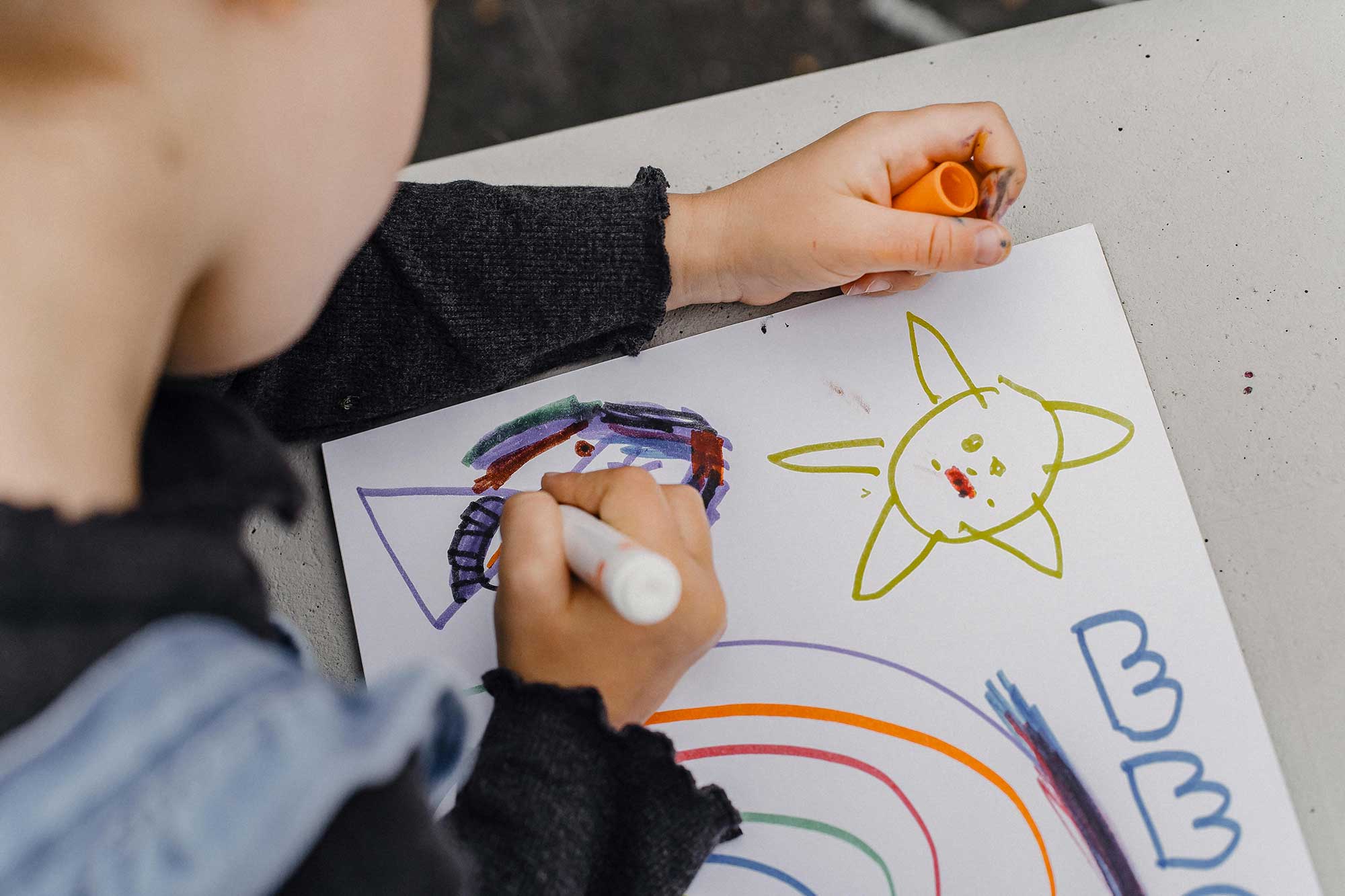
As the back-to-school season wraps up and fall sets in, many parents are settling into a new routine. However, beyond stocking up on school supplies, there is another crucial aspect to helping kids thrive: emotional support. The emotional rollercoaster of starting a new school year can sometimes be challenging, and one of the best ways to help children navigate their feelings is through art therapy. By tapping into their creativity, children can explore and express emotions that might otherwise be hard to articulate. Here are the top 8 reasons why art therapy is a great option for children’s emotional and developmental growth.
“I found I could say things with color and shapes that I couldn’t say any other way – things I had no words for.” G. O’Keeffe
1. Helps kids regulate their emotions
One of the biggest challenges for children is understanding and managing their emotions. While traditional therapy often focuses on verbal expression, art therapy allows kids to express what they’re feeling without needing to find the right words. Whether it’s through drawing, painting, or sculpting, children can use colors, shapes, and movement to release and process their emotions. For example, scribbling forcefully can be a healthy outlet for anger, while gentle strokes with a paintbrush may help calm anxiety. The act of creating becomes a safe space for kids to explore and make sense of their feelings (Team, 2024).
2. Reduces behavioral issues
When children struggle to express themselves verbally, emotions can quickly turn into disruptive behaviors like aggression, anxiety, or withdrawal. Art therapy provides an active and non-verbal channel for children to express their feelings. By offering them an outlet to safely process and release emotions, art therapy can reduce behavioral problems and help children feel more in control. With the help of an art therapist, kids can learn how to manage stress and frustration creatively, leading to fewer emotional outbursts and more positive behaviors (Wolfson, 2023).
3. Boosts Communication skills
It may sound counterintuitive, but art therapy enhances both verbal and non-verbal communication skills. By creating art, children can connect with their emotions in ways that help them gain clarity. This clarity translates into better verbal communication skills, as they learn to express their feelings in words after identifying them through their art. Art therapy has been especially effective for children with autism, helping them improve mental flexibility, self-image, and social communication skills (Schweizer et al., 2014). Art helps kids develop the vocabulary they need to express complex emotions, which is key for fostering productive communication at home, school, and with peers.
4. supports brain development
Creating art is not just fun—it’s a powerful way to enhance brain function. The act of making art engages multiple parts of the brain, including the frontal lobe (which helps with problem-solving), the motor cortex (which aids in fine motor skills), and the visual cortex (which processes visual information). Art also stimulates the limbic system, responsible for emotions and memory, allowing kids to reframe experiences and gain insights into their feelings (Nelson, 2025). These brain-boosting benefits are especially important during early childhood when the brain is still developing. In fact, studies show that engaging in creative activities helps build neuroplasticity, which strengthens brain connections and supports overall cognitive and emotional growth (Zaidel, 2009).
5. Builds self-esteem and Resilience
Art therapy provides children with the opportunity to create something they’re proud of, which can be a big confidence booster. But it’s not just about success—art also teaches kids to handle failure. The process of creating often involves unexpected results: a painting might not turn out as planned, or a sculpture may fall apart mid-project. But these “failures” offer valuable lessons in resilience. Learning to embrace imperfections and keep going teaches children that mistakes are part of the process and that success often comes after a few tries (Wolfson, 2023). This promotes a growth mindset, where children see challenges as opportunities to learn and grow.
6. Helps kids manage stress
Kids face stress just like adults, whether it’s the anxiety of starting school, dealing with bullies, or feeling overwhelmed by homework. Art therapy offers a way to cope with stress in a healthy and creative way. Whether it’s doodling, painting, or creating a collage, the act of making art has been shown to help calm the nervous system. In fact, studies suggest that engaging in creative activities can have a grounding effect, helping kids feel more centered and relaxed (Eastend Arts, 2023). For children dealing with stress or anxiety, art can provide a simple yet powerful tool for self-soothing and emotional regulation.
7. Improves relationship skills
Art therapy does more than just help kids with their emotions—it also supports social and emotional development. Through art, children learn to express themselves, which makes it easier for them to connect with others. As they explore their own feelings, they develop greater empathy for others as well. In group art therapy sessions, children can share their work and talk about the emotions behind it, fostering a sense of community and helping them develop stronger social bonds. This shared experience can help them form more meaningful relationships and practice empathy, which is essential for emotional and social growth (Peterson, 2021).
8. enhances motor skills
The physical act of creating art—whether it’s grasping a pencil, using scissors, or molding clay—helps children develop both fine and gross motor skills. These skills are foundational for later activities like writing, typing, and playing sports. Art therapy is especially beneficial for children who may have delays in their motor development, as it provides targeted exercises that help them build dexterity and coordination in a fun and engaging way (Eastend Arts, 2023). It also boosts self-esteem, as children feel empowered by their ability to complete tasks and make art independently.
So, Why art therapy?
Art therapy is more than just an opportunity for kids to have fun—it is a tool for emotional growth and cognitive development. By allowing children to express themselves creatively, art therapy helps them regulate their emotions, reduce stress, improve communication, and build confidence. Whether through solo or group art sessions, the benefits extend far beyond the art room, equipping kids with essential life skills that help them thrive in school and beyond.
If you’d like to see how Spotted Rabbit Studio art therapy can help your child to thrive, contact us today to learn more or have a free consult with one of our child & adolescent art therapists. We also offer art-based groups where kids can grow through play.

Kyle Lang, LCAT is licensed in New York State as a creative arts therapist. He has a MS from Nazareth College in creative arts therapy and has been practicing art-based psychotherapy since 2022. He offers individual therapy and facilitates a number of groups for kids, teens, and young adults including Spotted Rabbit Art Nights, and Kids’ Clay Workshops.
Kyle has advanced training in addressing emotion regulation, executive functioning, and behavioral issues using approaches rooted in IFS, CBT and art therapy.
References
Curry, S. (2021). Art and empathy: Four thought leaders explain the connection. ://new.artsmia.org/stories/art-and-empathy-four-thought-leaders-explain-the-connection
Eastend Arts and Humanities Counsel.(2023). Brushstrokes to Brain Development: The Benefits of Art in Early Childhood. https://eastendarts.org/benefits-of-art-in-early-childhood/
Konopka L. M. (2014). Where art meets neuroscience: a new horizon of art therapy. Croatian medical journal, 55(1), 73–74. https://doi.org/10.3325/cmj.2014.55.73
Nelson, K. (2025). The Neuroscience of Art: How Creativity Boosts Brain Function – Meet The Masters. https://meetthemasters.com/the-neuroscience-of-art-how-creativity-boosts-brain-function/#:~:text=Light%20up%20the%
Peterson, E. Understanding Arts Integration and SEL https://www.kennedy-center.org/education/resources-for-educators/classroom-resources/articles-and-how-tos/articles/educators/professional-development/understandingartsintegrationandsel2#:~:text=They%20allow%20us%20a%20space,for%20social%20and%20emotional%20learning
Schweizer, C., Knorth, E. J., & Spreen, M. (2014, October). Art therapy with children with Autism Spectrum Disorders: A review of clinical case descriptions on ‘what works.’ https://www.sciencedirect.com/science/article/abs/pii/S0197455614001087
Team, G. E. (2024). Art Therapy: Benefits, Techniques & How It Works. https://www.goodtherapy.org/learn-about-therapy/types/art-therapy
Wolfson, P. (2023). How Art Therapy Can Help Children with Behavioral and Emotional Issues. https://ketamineresearchfoundation.org/how-art-therapy-can-help-children-with-behavioral-and-emotional-issues/
Zaidel DW. (2009). Art and brain: insights from neuropsychology, biology and evolution. Journal of anatomy, 216(2), 177–183. https://doi.org/10.1111/j.1469-7580.2009.01099.x
